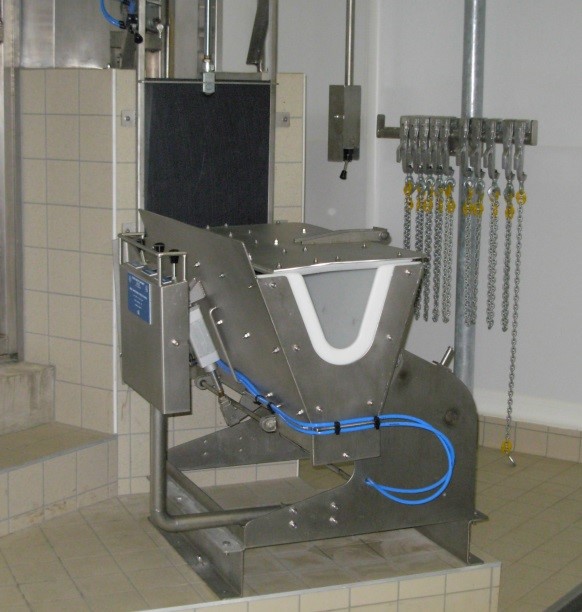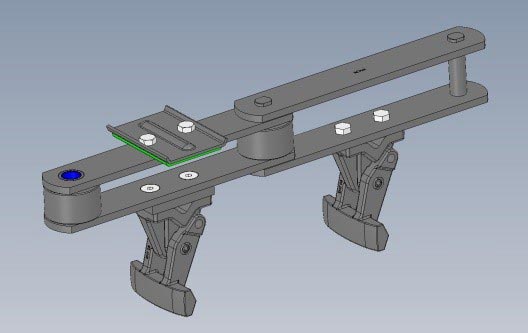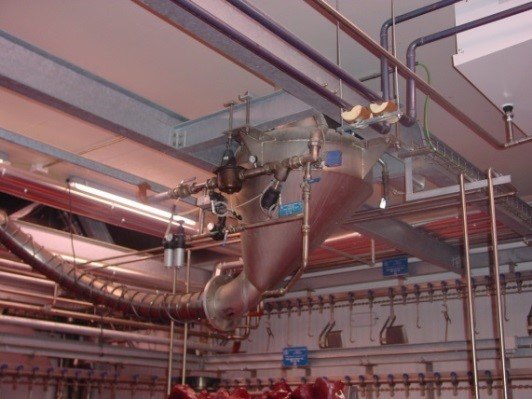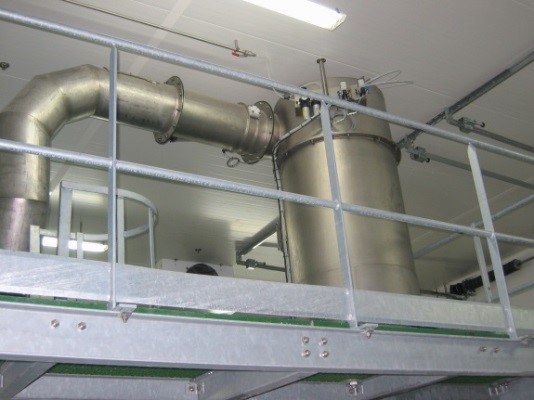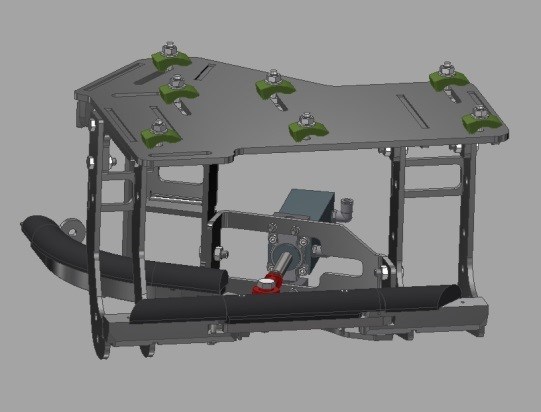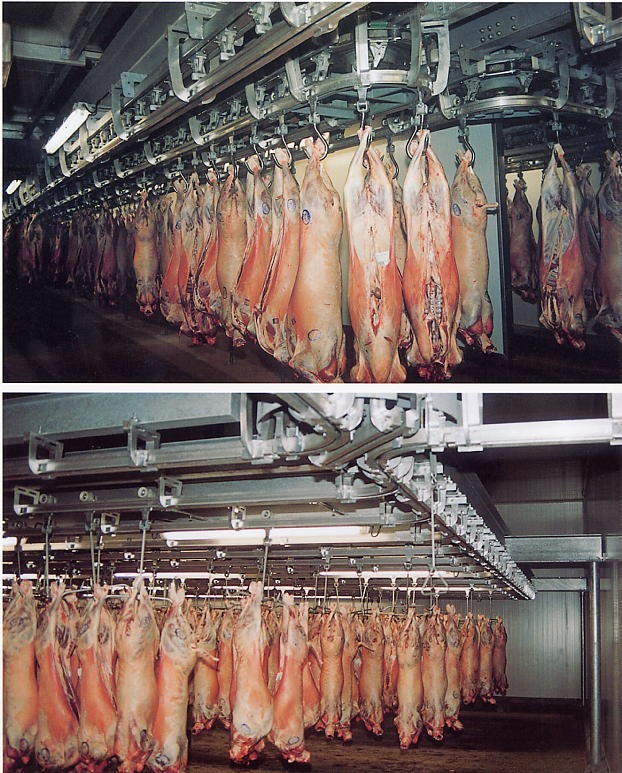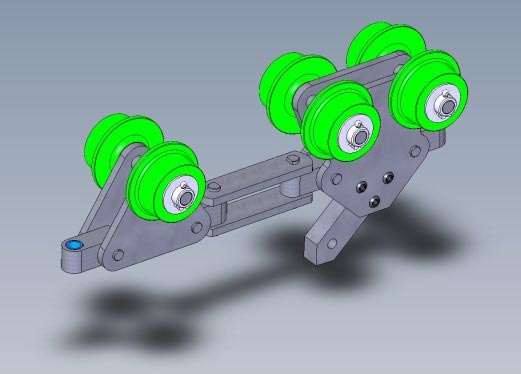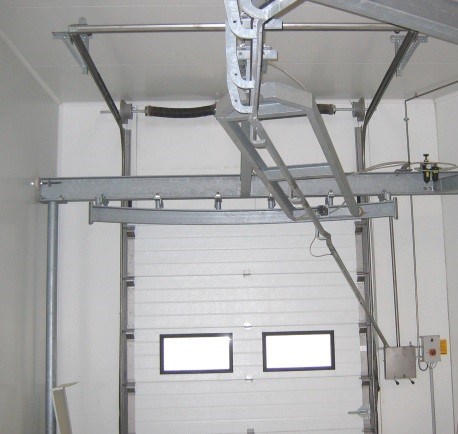Sheep slaughter lines
The sheep slaughtering has remained very manual until recently.
To meet growing needs for productivity and ergonomics, we have developed a range of processes and machines to optimize the ratio: sheep/operator/hour while ensuring good working conditions for the operators.
Advantages
- Customized solutions
- Lines from 10 to 400 sheep/hour
- Integration of constraints related to the agro food industry
- Ergonomic design of workstations
- All our materials comply with the European Machinery Directive
We offer a range of box and restrainer to meet different needs in terms of throughputs and rite.
A good anaesthesia being a key point for the quality of the meat. We bring particular attention to the material of electro narcosis as the material of contention.
The Freund anaesthesia boxes send a moderate current that limits the risk of fractures and blood stains.
Our compression materials ensure a good presentation of the sheep for the anaesthesia, while respecting animal welfare (in accordance with the 1099/2009 regulations).
For the ritual slaughtering, the box, which will then be pre-oriented, allows a 90° rotation of the animal for the throating.
- Box for manual anaesthesia or throating
- Restrainer for manual anaesthesia
- Restrainer with variable spreader
After an electrical anaesthesia, the sheep should be bled as quickly as possible.
Our bleeding tables allow a good presentation of the animal to the operator and an excellent recovery of the blood.
The hygienic design of our tables allows for easy cleaning of all surfaces.
After bleeding, the slinging or setting on the gambrels is done at a good height and without risk to the operator.
In the case of a vertical bleeding, the hooking of the animal is facilitating by the design of the table, thus minimizing the time between anaesthesia and bleeding.
The de hiding of sheep is very difficult and very physical for operators. Also, in collaboration with our customers, we have developed a whole range of equipment for assistance for de-hiding, and fully automatic machines.
- Pre-de hiding belt
- Manual or automatic brisket skinner
- Pneumatic fist for flanks
- Automatic shoulder-screw
- Final de-hider Jason type
- Final de-hider for reverse de-hiding
- Automatic leg cutters
We also install the de-hiding equipment from the Spanish company Sadurni Innovatec, including the famous « bistouri ».
The careful study of the workstations, whether on the floor or on fixed or elevating platforms, is an essential point for the quality of the work on the carcass, for the productivity of the workstation and for the comfort of the operator.
Our perfect knowledge of the operations on the carcass and the exchanges that we have with our customers during the phase of development of the projects, allows us to optimize each workstation.
Each is equipped with the necessary hygiene equipment for the operations to be carried out.
The design of each platform integrates the cleanability, safety and maintainability rules acquired by our Design Office over 30 years of dialogue with the cleaning, maintenance departments and control organizations.
- Fixed height platforms
- Elevating platforms
The loads carried by the chain conveyor need to be transported smoothly to the slaughter line. Conventional mechanical chains require lubrication to operate in a normal and sustainable way. Veterinary constraints no longer allow regular greasing of the chains. This results in a fast degradation of these and accelerated replacements.
As a chain manufacturer, we started working on this topic more than 20 years.
Our R&D department, in collaboration with the maintenance engineers of our customers, have developed a range of chain (Autolub) that does not require any greasing.
The heat, surface treatments and the specific rings used, allow our chains to resist wear and oxidation, despite the very aggressive conditions of use during the production or cleaning phases.
Unlike the big manufacturers, who work primarily for automakers, we manufacture more than 80% of our chains for food related applications, with its constraints. (Ambient humidity, corrosive cleaning products).
Our range of conveyor chains can cover all the needs of a sheep slaughter chain, from hammock conveyors to offal conveyors.
The material which the channels to cover the slaughter chain and many co-products, troughs and gut room tables, which need to be worked on. May seem very basic, however, requires specific attention during their design and manufacture. They must be easily washable and have no retention zone (Inaccessible fold to washing, non-continuous weld)
Our designs are based on our long experience in the slaughterhouses industry, integrates cleanability from the design, and our quality department ensures strict control over the state of welds before shipping materials.
Products such as legs, hides, suet, bellies can be conveyed by belt.
For these materials too, the cleanability is a key point, whether in the frame or the conveyor belt. In addition to the hygienic reason of our belts, we incorporate washing ramps for continuous cleaning of belts.
Slaughter halls are often overloaded areas. We take special care to reserve access for maintenance and design our machines to limit the intervention time of technicians.
These conveyors collect offal along the slaughter line for inspection. They can also be used for cooling.
Our aerial conveyors of offal transport are completely in stainless steel and perfectly accessible for cleaning. Moreover, their opening structure allows them to move circulate neat operators without generating risk.
.
Pneumatic transfer systems can transport products over distances up to 100m.
We use two different processes:
The pneumatic cannon is used for fluid products such as: hot fats and stercoral matter. Our cannons, considered as pressurized equipment, are subjected to tough tests with recordings for validating their conformity. They are completely in stainless steel, as well as the pipes and the decompression cyclones.
The other method is the aspiration which allows transporting non-liquid products such as: heads, legs, hides (pipes up to diameter 350 mm). The method authorizes several points of collect for a same aspiration.
The drain elements, pipes and removal airlock of products are completely made in stainless steel.
Storage areas of carcasses after slaughtering are often overloaded and although the equipment may appear basic, it must be carefully design, manufacture and install with care.
The support frame, must of course, take in consideration the carcasses loads, but must also be calculated to avoid bending that would affect the proper functioning of switches.
We calculate and manufacture our frames with dedicated software that allow optimizing our supporting structure (CM66 calculation rules and Eurocode).
We offer several types of networks: round bar network and twin track rail for an adaptation of our customers’ installations.
For each kind of network, we dispose of a completely range of accessorizes: Hooks, manual or pneumatic switches, introducers, etc.
Since several years, we offer a «plastic» rail (patented) allowing a significant reduction of efforts and rolling noises when moving loads:
- Round bar network in galvanized steel
- Round bar network in plastic
- Round bar network in stainless steel
- Round bar network in aluminium
- Twin track rail in galvanized steel
- Twin track rail in stainless steel
The loads carried by the chain conveyor need to be transported smoothly to the slaughter line. Conventional mechanical chains require lubrication to operate in a normal and sustainable way. Veterinary constraints no longer allow regular greasing of the chains. This results in a fast degradation of these and accelerated replacements.
As a chain manufacturer, we started working on this topic more than 20 years. Our R&D department, in collaboration with the maintenance engineers of our customers, have developed a range of chain (Autolub) that does not require any greasing.
The heat, surface treatments and the specific rings used, allow our chains to resist wear and oxidation, despite the very aggressive conditions of use during the production or cleaning phases.
Unlike the big manufacturers, who work primarily for automakers, we manufacture more than 80% of our chains for food related applications, with its constraints. (Ambient humidity, corrosive cleaning products).
Our range of loading arm allows us to suggest affective and safe solutions for the transfer of carcasses, quarters, Christmas trees and even for the setting in hammock in the trucks of half-cattle.
All our arms are hydraulic and in conformity to the regulatory meets for the lifting.
To facilitate the grasping of loads, we can equip our arms with hydraulic tongs adapted to pigs or beef.




